Motion in a Straight Line
Important Questions on Motion in a Straight Line
A particle has an initial velocity and an acceleration of . Its speed after is,
A ball is thrown upwards and it returns to ground describing a parabolic path. Which of the following remains constant?
Consider a body of mass at rest at the origin at time A force is applied on the body, where The torque acting on the body about the origin at time is . Which of the following statements is (are) true?
A striker is shot from a square carom board from a point A exactly at midpoint of one of the walls with a speed at an angle of with the as shown. The collisions of the striker with the walls of the fixed carom are perfectly elastic. The coefficient of kinetic friction between the striker and board is
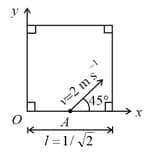
A monkey of mass is climbing on a rope with one end fixed to the ceiling . If it wishes to go up with an acceleration, how much force should it apply to the rope? If the rope is long and the monkey starts to rest, how much time will it take to reach the ceiling?
Figure shows the displacement of a particle going along the -axis as a function of time. Find the region where force acting on the particle is zero.
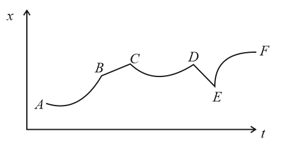
An open tank long and deep, is filled up to a height of oil of specific gravity The tank is accelerated uniformly from rest to a speed of . The shortest time (in seconds) in which this speed may be attained without spilling any oil (in sec).
There is an inclined surface of inclination . A smooth groove is cut into it forming angle with . A steel ball is free to slide along the groove. If the ball is released from the point at top end of the groove, the speed when it comes to is
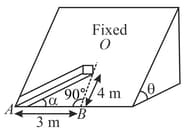
A mass is moving in a plane with its and coordinates given by and , where and are in meters and is in second. Find the magnitude of the net force acting on this mass at .
The velocity of end of rigid rod placed between two smooth vertical walls is along vertical direction. Find out the velocity of end of that rod, when it slips down.Rod always remains in contact with the vertical wall and also find the velocity of centre of mass of the rod. Also find equation of path of centre of rod.
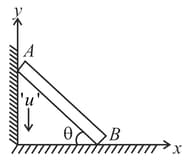
A retarding force is applied to stop a train. The train stops after . If the speed is doubled, then the distance travelled when the same retarding force is applied is
A particle is moving with speed along the positive -axis. Calculate the speed of the particle at time (assume that the particle is at the origin at ).
A small ball rolls of the top of a stairway horizontally with a velocity of . Each step is high and wide. If is , then the ball will strike the step where is equal to (assume ball strike at the edge of the step).
Two particles are thrown from the top of a tower with the same speed in upward and downward directions simultaneously. If the first particle hits the ground in time and the second particle takes time after the first one hitting the ground to hit the ground. Then find
Maximum height attained by the second particle above the tower.
Height of tower
A train stopping at two stations apart on a straight line takes for the journey. Assuming that its motion is first uniformly accelerated and then uniformly retarded. Prove that , where and are the magnitude of the acceleration and retardation, respectively, in
The maximum possible acceleration of a train starting from the rest and moving on a straight track is and maximum possible retardation is . The maximum speed that a train can achieve is . Minimum time in which the train can complete a journey of ending at rest is . Where is an integer. Find .
From a point located on a highway (figure) one has to get by car as soon as possible to the point located in the field at a distance from the highway. It is known that the car moves in the field times slower than on the highway. At what distance from point one must turn off the highway?
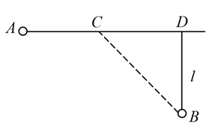
A body is thrown vertically upwards. Which one of the following graphs correctly represents the velocity versus time?
From a tower of height , a particle is thrown vertically upwards with a speed . The time taken by the particle, to hit the ground is times that taken by it to reach the highest point of its path. The relation between , and is,
An object moving with a speed of , is decelerated at a rate given by: where is the instantaneous speed. The time taken by the object, to come to rest would be:

